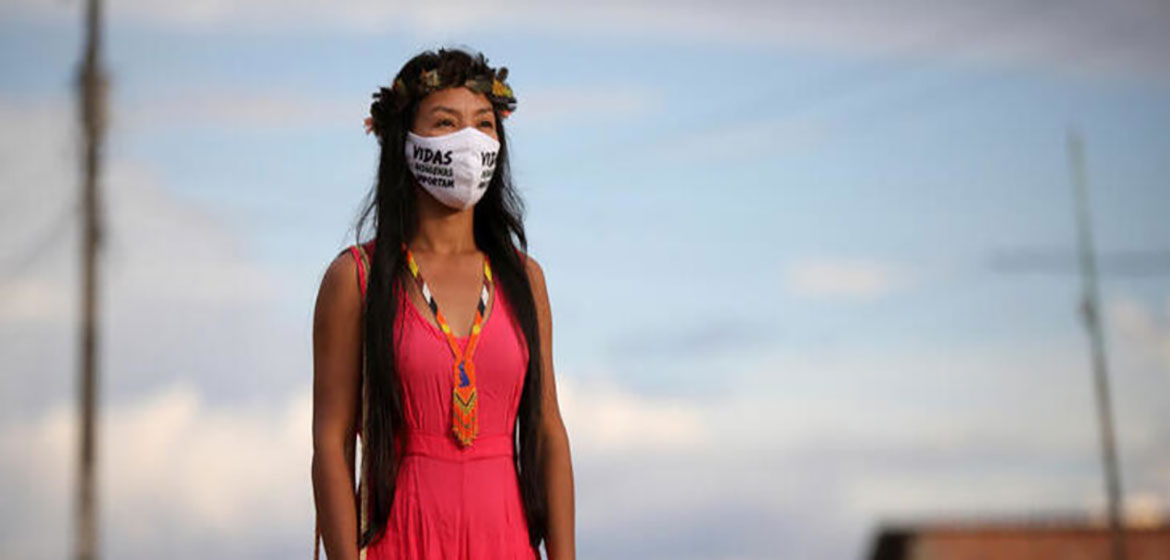- Food security and water scarcity are putting indigenous communities at risk amid the coronavirus pandemic.
- Information can be scarce and is sometimes not in the appropriate languages.
- But tech is bringing together people from different parts of the world, helping them share ideas and support through webinars and other platforms.
“If you don’t have access to clean water, how can you be expected to wash your hands every hour?”
Hindou Oumarou Ibrahim, the President of the Association for Indigenous Women and Peoples of Chad, is used to talking about the unique challenges indigenous communities face.
She’s recognized as an expert on how climate change is affecting indigenous people around the world, and took part in the Averting a Climate Apocalypse session during the .
A member of the Mbororo community and a passionate supporter of traditional, sustainable cultures, Hindou is now immersed in supporting global indigenous cultures as they respond to the coronavirus pandemic.
Hindou Oumarou Ibrahim, president of the Association for Indigenous Women and Peoples of Chad. Image: REUTERS/Denis Balibouse
Here, we ask her about how the pandemic is hitting traditional communities and how indigenous people from around the world are supporting one another.
How is the pandemic affecting Chad, and the Mbororo people?
The Mbororo are an indigenous, nomadic community. Traditionally, we were cattle herders and most of us still live a life that is all about moving from one place to another – looking for pastures and water. Most of us live around Lake Chad, spread between Chad, Cameroon, Niger, Nigeria and South Africa.
There is lots of information, advice and guidance on how to stay safe and reduce your risk of catching or spreading COVID-19. But it is not published with indigenous people in mind.
The information is given in the two official languages, Arabic and French, but not traditional ones. Also, it is available in towns but impossible to get in remote areas where there might not be TV or radio coverage, and there certainly isn’t internet access. So people don’t understand there might be a curfew or a quarantine order, which could lead them into conflict with the authorities.
But they know there is a sickness because they see the disruption in their daily lives, with markets and other public places closed. Their biggest worry is that if they can’t go to the market, they can’t buy food for their families.
What daily challenges are people facing?
For many, many people the reality of daily life is this – if you don’t have access to clean water, how can you be expected to wash your hands every hour? It’s just not possible. People are still getting their drinking water from rivers and lakes. They’re relying on the same water that animals drink from. You can’t ask them to get some soap or alcohol hand gel.
One of the most effective ways to keep a community safe is to keep it isolated from other communities. If we can stop the virus spreading like this, that can help. It will only take one infected person to put an entire community in danger.
But it’s not always easy. People face difficult choices every day. The biggest daily issue is getting enough food for yourself and your family sometimes means interacting with people from somewhere else. Across many African countries, people are saying that the virus will kill some and let some live, but a lack of the food will kill all of us. So they take that risk.
How are indigenous communities helping each other?
Indigenous peoples around the world are coming together and sharing experiences and ideas. We’re connecting over the internet – webinars, that sort of thing.
I’ve learned that no matter where they are indigenous people are having similar experiences of the pandemic. It’s because we live in remote areas and depend on things like markets to feed ourselves, and because there are lots of people struggling to find water.
So Brazilian people tell me their water is polluted. What do they do to find safe water, then? Well, they have to get outside of their reserves and get water from another place. And when they go outside, they come into contact with other communities and face the danger of infection.
I’ve heard from indigenous people in the US that it’s the same for them, and they do not always have hospital facilities to turn to. And our friends and colleagues in Ecuador report a similar situation. They tell us: “Yes we are in the rainforest and it's raining. But our water is polluted.”
So we try to support each other by exchanging information. I talk about how I'm running a project to create masks and working to get food supplies. And then the other communities say: “Oh, that's a good idea. Who can we find to make masks for us and share them with the most vulnerable?”
One of the things I learned from them is that it’s very important to take care of old people separately. That isn’t something that is part of our culture at all. So from my colleagues from the US, I’ve been hearing about how we can protect our elders, even if that means we isolate them before they get sick.
Source:
Related to SDG 10: Reduced inequalities and SDG 3: Good health and well-being




